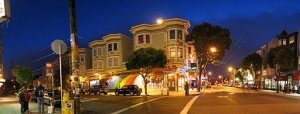🌸 Haight-Ashbury: The Psychedelic Birthplace of the Hippie Movement
At the turn of the 20th century, the Haight-Ashbury district in San Francisco wasn’t the epicenter of flower power just yet. It was a newly developing upper-middle-class suburb, its streets lined with grand Victorian homes nestled neatly into narrow city parcels.
Just a few years earlier, the area had been little more than farmland and sand dunes, but the arrival of the Haight Street Cable Railroad changed that. By connecting the neighborhood to downtown San Francisco, it paved the way for stylish city dwellers to move west.
🚗 From Suburbia to Struggle: The Pre-Hippie Years

Like many urban neighborhoods, Haight-Ashbury’s early promise didn’t last forever.
By the Great Depression, the area had already begun to decline. The rise of the automobile allowed the middle class to sprawl into newer suburbs. World War II only accelerated the change—creating a need for low-cost housing and spurring the division of once-stately homes into cramped apartments and boarding houses.
By the 1950s, the neighborhood was in rough shape. Maintenance was neglected, the middle class had moved out, and the area was full of vacant or subdivided rentals. But what was a loss for some became an opportunity for others—especially struggling artists and musicians.
🎶 A Magnet for Musicians and Misfits
San Francisco had long been a haven for the arts, with a reputation for free-thinking and a slightly rebellious edge. So when cheap rent and large, shareable homes became available in Haight-Ashbury, it didn’t take long for creative minds to move in.
By the mid-1960s, the intersection of Haight and Ashbury Streets became the beating heart of a new cultural revolution. Musicians, poets, dropouts, and dreamers all found common ground in its coffeehouses, parks, and porches.
🌈 The Birthplace of the Hippie Movement
The neighborhood’s transformation from forgotten suburb to cultural landmark wasn’t just accidental—it was the result of social conditions, creative energy, and timing.
The area attracted:
- Leftover Beatniks from the prior generation
- A growing anti-war and civil rights movement
- The spread of psychedelic music and drug culture
- Nearby open spaces like Golden Gate Park and Buena Vista Park, which gave musicians and hippies space to gather, camp, and, occasionally, drop acid
It’s no surprise that by 1967, people jokingly referred to the neighborhood as “Hashbury”—a play on words that said as much about the vibe as it did the smell.
🎸 Who Lived in Haight-Ashbury?
Let’s just say if you were hanging out in the Haight in the mid-60s, your neighbors might’ve been famous.
Notable Residents & Regulars:
- Janis Joplin
- Jerry Garcia and The Grateful Dead
- Jimi Hendrix
- Grace Slick and Jefferson Airplane
- The Mamas & the Papas
- Big Brother and the Holding Company
- Quicksilver Messenger Service
Most lived just blocks from each other and often crossed paths at neighborhood parties, jam sessions, and community events. It wasn’t just about fame—it was about freedom, expression, and being part of something bigger.
📍 Today, you can visit 710 Ashbury Street, where The Grateful Dead once lived—now a pilgrimage spot for Deadheads.
🛍️ Haight-Ashbury Today: From Tie-Dye to Trendy
These days, Haight-Ashbury is a different kind of cool.
The once run-down Victorians have been lovingly restored, the once dirt-cheap rents are now sky-high, and the vibe is more vintage boutique than barefoot commune.
Still, the spirit remains. Walk down Haight Street today and you’ll pass:
- Upscale cafés
- Tie-dye T-shirt shops
- Record stores stocked with vinyl classics
- And yes, even a Ben & Jerry’s on the corner of Haight and Ashbury (with “Cherry Garcia” proudly on the menu)
🎶 Final Thought: Where the Music Still Echoes
The Haight-Ashbury district was more than just a neighborhood—it was the nexus of a movement. A place where music, peace, protest, and psychedelia collided in the most colorful way possible.
While the Summer of Love has long since passed, its legacy continues to bloom. And even now, walking those streets, you can almost hear the echo of a distant guitar riff and the hopeful chorus of a generation saying:
“Turn on, tune in, and drop by.”